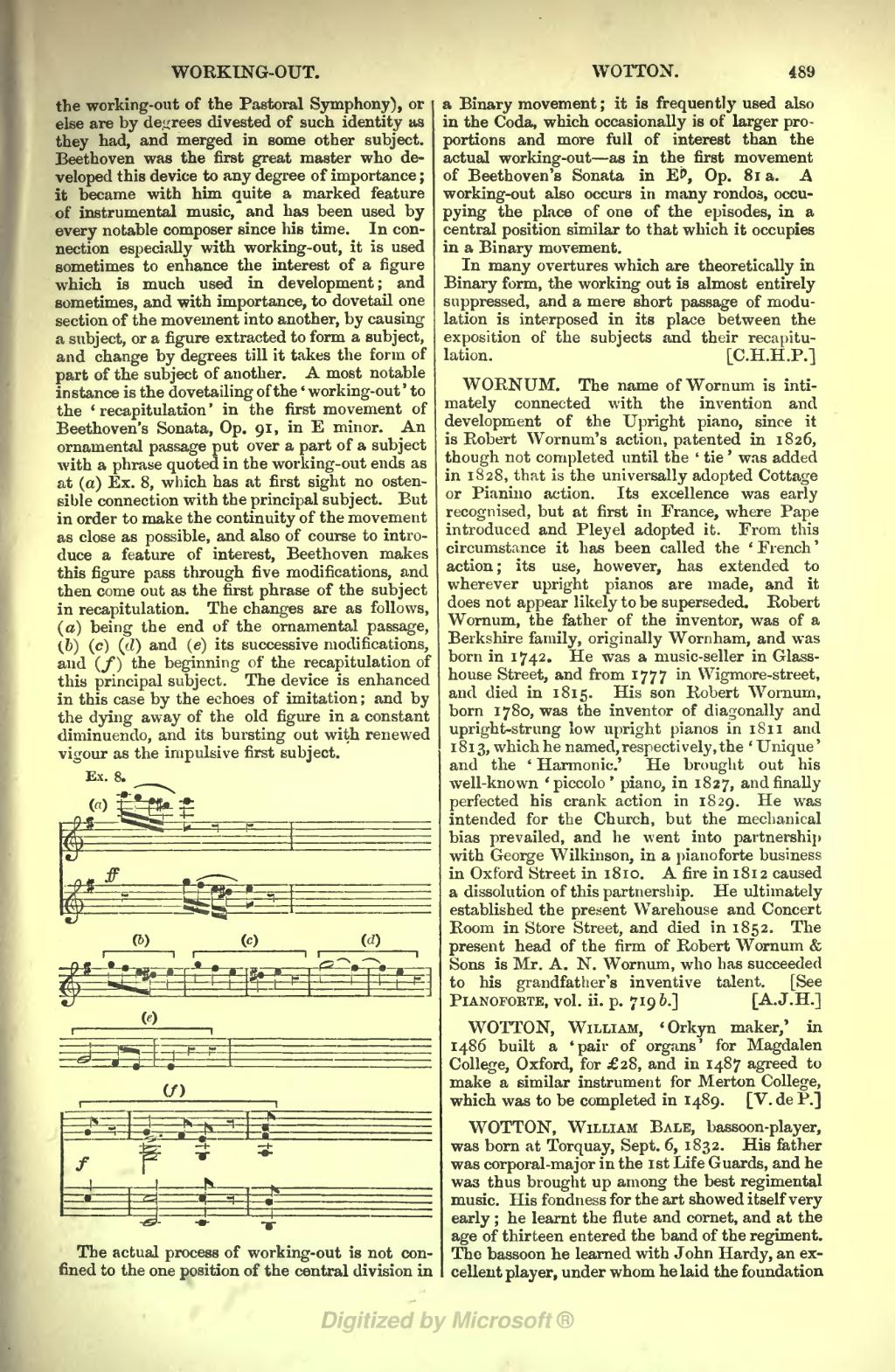the working-out of the Pastoral Symphony), or else are by decrees divested of such identity as they had, and merged in some other subject. Beethoven was the first great master who developed this device to any degree of importance; it became with him quite a marked feature of instrumental music, and has been used by every notable composer since his time. In connection especially with working-out, it is used sometimes to enhance the interest of a figure which is much used in development; and sometimes, and with importance, to dovetail one section of the movement into another, by causing a subject, or a figure extracted to form a subject, and change [App. p.817 "read or a figure extracted from a subject, to change, etc."] by degrees till it takes the form of part of the subject of another. A most notable instance is the dovetailing of the 'working-out' to the 'recapitulation' in the first movement of Beethoven's Sonata, Op. 91, in E minor. An ornamental passage put over a part of a subject with a phrase quoted in the working-out ends as at (a) Ex. 8, which has at first sight no ostensible connection with the principal subject. But in order to make the continuity of the movement as close as possible, and also of course to introduce a feature of interest, Beethoven makes this figure pass through five modifications, and then come out as the first phrase of the subject in recapitulation. The changes are as follows, (a) being the end of the ornamental passage, (b) (c) (d) and (e) its successive modifications, and (f) the beginning of the recapitulation of this principal subject. The device is enhanced in this case by the echoes of imitation; and by the dying away of the old figure in a constant diminuendo, and its bursting out with renewed vigour as the impulsive first subject.
Ex. 8.
A musical score should appear at this position in the text. See Help:Sheet music for formatting instructions |
The actual process of working-out is not confined to the one position of the central division in a Binary movement; it is frequently used also in the Coda, which occasionally is of larger proportions and more full of interest than the actual working-out—as in the first movement of Beethoven's Sonata in E♭, Op. 81a. A working-out also occurs in many rondos, occupying the place of one of the episodes, in a central position similar to that which it occupies in a Binary movement.
In many overtures which are theoretically in Binary form, the working out is almost entirely suppressed, and a mere short passage of modulation is interposed in its place between the exposition of the subjects and their recapitulation.
WORNUM. The name of Wornum is intimately connected with the invention and development of the Upright piano, since it is Robert Wornum's action, patented in 1826, though not completed until the 'tie' was added in 1828, that is the universally adopted Cottage or Pianino action. Its excellence was early recognised, but at first in France, where Pape introduced and Pleyel adopted it. From this circumstance it has been called the 'French' action; its use, however, has extended to wherever upright pianos are made, and it does not appear likely to be superseded. Robert Wornum, the father of the inventor, was of a Berkshire family, originally Wornham, and was born in 1742. He was a music-seller in Glasshouse Street, and from 1777 in Wigmore-street, and died in 1815. His son Robert Wornum, born 1780, was the inventor of diagonally and upright-strung low upright pianos in 1811 and 1813, which he named, respectively, the 'Unique' and the 'Harmonic.' He brought out his well-known 'piccolo' piano, in 1827, and finally perfected his crank action in 1829. He was intended for the Church, but the mechanical bias prevailed, and he went into partnership with George Wilkinson, in a pianoforte business in Oxford Street in 1810. A fire in 1812 caused a dissolution of this partnership. He ultimately established the present Warehouse and Concert Room in Store Street, and died in 1852. The present head of the firm of Robert Wornum & Sons is Mr. A. N. Wornum, who has succeeded to his grandfather's inventive talent. [See Pianoforte, vol. ii. p. 719b.]
WOTTON, William, 'Orkyn maker,' in 1486 built a 'pair of organs' for Magdalen College, Oxford, for £28, and in 1487 agreed to make a similar instrument for Merton College, which was to be completed in 1489.
WOTTON, William Bale, bassoon-player, was born at Torquay, Sept. 6, 1832. His father was corporal-major in the 1st Life Guards, and he was thus brought up among the best regimental music. His fondness for the art showed itself very early; he learnt the flute and cornet, and at the age of thirteen entered the band of the regiment. The bassoon he learned with John Hardy, an excellent player, under whom he laid the foundation
